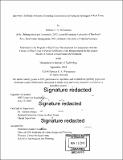Innovative mobility solutions disrupting conventional investment paradigms in real estate
Author(s)
Weissmann, Dietmar E. A
DownloadFull printable version (10.38Mb)
Other Contributors
Massachusetts Institute of Technology. Center for Real Estate. Program in Real Estate Development.
Advisor
Andrea Chegut.
Terms of use
Metadata
Show full item recordAbstract
One might argue real estate is entering a period where technological innovations have greater impact on investment returns than conventional metrics related to the overall economy. While this has already been demonstrated by e-commerce disrupting the retail and logistics landscape, industry leaders are now starting to become more and more attentive to mobility related implications, resulting from the recent advent of ride-hailing providers like Uber, Lyft, and Didi. Broad literature, generated over the past decades and applying widely recognized econometric concepts, emphasizes the significance of public transport access for residential real estate values. More recently, claims arose that the value of proximity to public transport is being challenged by ride-hailing, serving as a substitute for rail and bus services. While the existence of a certain substitution effect is supported and documented by academic studies, research about its impact on real estate is rare. This thesis analyzes the value change of public transport access over time, by applying a hedonic regression model to a sample of 257,100 residential real estate transactions which have taken place in New York City between January 2005 and June 2018. The distance between each individual home and the closest of 550 heavy rail transit stops is used to determine the value of proximity to public transport in these transactions. Contrary to anecdotal claims and economic theory, the results of this analysis suggest that the value of proximity, i.e. rent gradients towards heavy rail transit stops, increases over the observed time period, especially since the emergence of Uber and within walking distance (0.5 miles) from transit access points. Since mobility innovation's long-term effects might not be in line with short-term implications and notable regional variances might exist, the thesis recommends ongoing analysis of the subject matter and expanding the research from New York City to various markets with different urban shapes, transportation modes, and demographics.
Description
Thesis: S.M. in Real Estate Development, Massachusetts Institute of Technology, Program in Real Estate Development in conjunction with the Center for Real Estate, 2018. Cataloged from PDF version of thesis. Includes bibliographical references (pages 61-65).
Date issued
2018Department
Massachusetts Institute of Technology. Center for Real Estate. Program in Real Estate Development.; Massachusetts Institute of Technology. Center for Real EstatePublisher
Massachusetts Institute of Technology
Keywords
Center for Real Estate. Program in Real Estate Development.